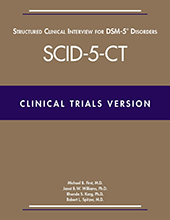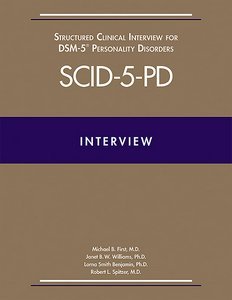

The present results corroborate the notion that, among others, suicide attempts appeared to be less related to premeditation, but rather to impul-sive and thus spontaneous behavior. Conclusions: Compared to healthy controls, individuals reporting a recent suicide attempt also reported a higher propensity to thrill and sensation seeking and impulsive behavior as a proxy of risk-taking behavior. Compared to HCs, SAs showed the highest scores for thrill and sensation seeking and impulsive behavior. The risk-taking questionnaire yielded a four-factor so-lution: Thrill and sensation seeking Cautious procedure Cautious decision making Impulsive behavior. Results: Compared to HCs, individuals with SA reported higher risk-taking and suicidal behavior scores.
#Scid dsm 5 series#
Partici-pants completed a series of self-rating questionnaires covering sociodemographic information, risk-taking (Risk-Taking Questionnaire-18 RT-18) and suicidal behavior (Suicide Behaviors Questionnaire Revised SBQ-R).

Of those, 240 (39 %) were individuals with a suicide attempt (SA) within a time lapse of one to three months, and 376 (61 %) were healthy controls (HC). Methods: A total of 616 individuals (mean age: 27.07 years 51.5% fe-males) took part in the study. In the present study, we investigated, if suicide at-tempters (SAs) reported higher scores for risk-taking, when compared to healthy controls (HC) of the general population. Among others, suicidal behavior is associated with impulsivity, risk taking, pain tolerance and a state of over-arousal. Enhancing the reliability and validity of DSM-5 diagnostic assessments, the SCID-5-CV will serve as an indispensible interview guide.Background: Suicidal behavior is a major mental health concern both for the individual and for the public health. For example, it can ensure that all of the major DSM-5 diagnoses are systematically evaluated in adults characterize a study population in terms of current psychiatric diagnoses and improve interviewing skills of students in the mental health professions, including psychiatry, psychology, psychiatric social work, and psychiatric nursing.

Versatile in function, the SCID-5-CV can be used in a variety of ways.

It also screens for 17 additional DSM-5 disorders. A unique and valuable tool, the SCID-5-CV covers the DSM-5 diagnoses most commonly seen in clinical settings: depressive and bipolar disorders schizophrenia spectrum and other psychotic disorders substance use disorders anxiety disorders (panic disorder, agoraphobia, social anxiety disorder, generalized anxiety disorder) obsessive-compulsive disorder posttraumatic stress disorder attention-deficit/hyperactivity disorder and adjustment disorder. The SCID-5-CV is an abridged and reformatted version of the Research Version of the SCID, the structured diagnostic interview most widely used by researchers for making DSM diagnoses for the past 30 years. Interview questions are provided conveniently along each corresponding DSM-5 criterion, which aids in rating each as either present or absent. The Structured Clinical Interview for DSM-5 -Clinician Version (SCID-5-CV) guides the clinician step-by-step through the DSM-5 diagnostic process.


 0 kommentar(er)
0 kommentar(er)
